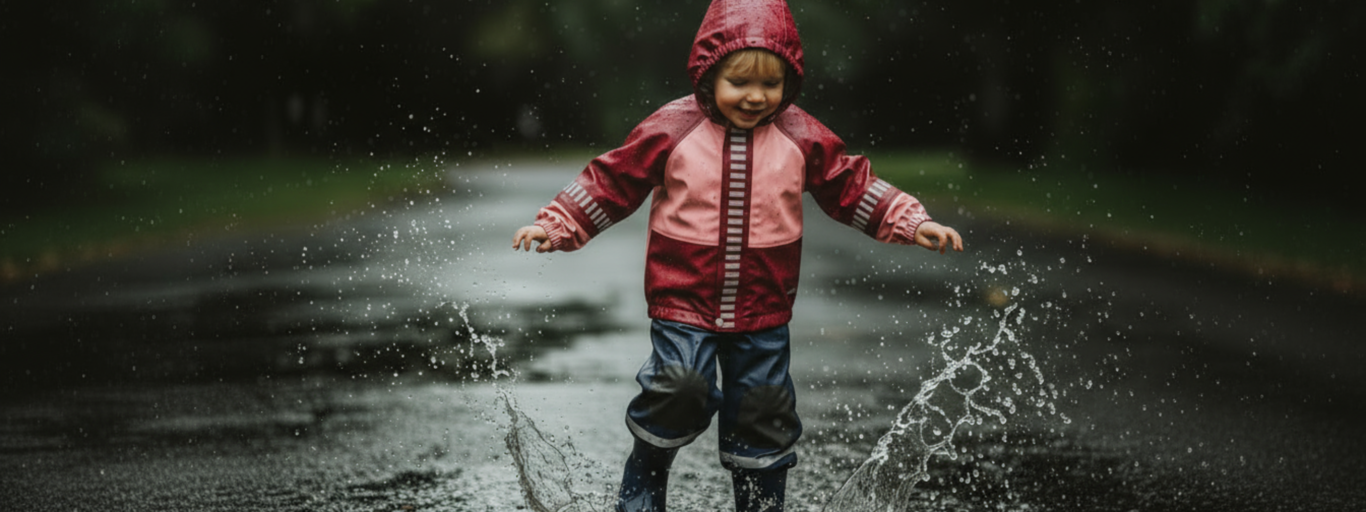- Tips og Råd
- Påkledning
- Barnehagestart

Alt du trenger: forberedelser, bekledning og pakkeliste
Å begynne i barnehagen er en stor milepæl både for barnet og foreldrene. Her får du nyttige tips til forberedelser, tilvenning, bekledning, pakkeliste – og praktiske råd om søvn, sekk og sko.
Før oppstart
Forberedelser før oppstart
En god forberedelse kan gjøre barnehagestarten tryggere og enklere både for barnet og dere foreldre. Her er noen enkle ting dere kan gjøre i forkant:
- Besøk barnehagen sammen med barnet før oppstart.
- Snakk positivt om hverdagen i barnehagen.
- Les bøker om barnehagestart sammen.
- La barnet øve på å kle av og på seg selv.
Gode klær for barnehagen
Trygt og forutsigbart
Tilvenning
De første dagene handler om å bli kjent med voksne, barn og rutiner. Hold dagene korte i starten, og gi barnet forutsigbarhet.
Planlegg sammen
Avtal en rolig oppstartsplan med barnehagen (korte dager, tydelige tider).
Klare beskjeder
Gi faste beskjeder ved levering: hvem henter, når og hvor.
Trygghetsting
Ha med en koseklut, bamse eller smokk – noe kjent roer overgangen.
Like avskjeder
Hold avskjeder korte, vennlige og like hver dag.
Snakk om dagen
Ved henting – løft fram små, positive øyeblikk for å styrke mestring.
Lag-på-lag gir fleksibilitet
Bekledning
I barnehagen er det mye lek ute, i all slags vær. Lag-på-lag gjør det enkelt å justere etter temperatur og aktivitet.
Innerlag
Ull eller bambus holder barnet varmt og tørt – også når det blir svett.
Mellomlag
Fleece eller ull gir ekstra isolasjon på kalde dager.
Ytterlag
En vind- og vanntett dress beskytter mot regn, snø og vind.
Fleksibelt og komfortabelt
Lag på lag – en smart måte å kle barna
Sveip sidelengs på mobil – eller se alle lag under
1. Innerlag
Velg et pustende lag som transporterer fukt vekk fra huden. Ull eller ull/bambus er trygge valg.
Se ullklær2. Mellomlag
Isolerende lag som gir varme. Ull eller fleece gjør susen – justér etter vær og aktivitet.
Se fleece3. Ytterlag
Vind- og vanntett dress eller jakke + bukse beskytter mot været. Velg pustende materialer for komfort.
Se yttertøyPraktisk og oversiktlig
Pakkeliste – klær og utstyr til plassen i barnehagen
- Parkdress
- Regntøy, regnvotter og sydvest
- Vinterdress
- Fleece- eller ulldress (hel eller todelt)
- 1–2 skift med inneklær
- Tynn lue eller solhatt
- Tykk lue (balaklava med vindstopper)
- Tynne votter med plass til ullvotter under
- Tykke votter (ullfôr)
- Hals eller buff
- Solkrem
- Solbriller
- Innesko
- Gummistøvler
- Overgangsko og vinterstøvler
- Et kosedyr de kjenner godt
- Navnelapper på alt
- Et stort handlenett for å ta med alt skittentøyet hjem etter en dag fylt av lek, sand og moro
💡 Ha alltid et ekstra par sokker og votter i sekken – de vil bli brukt.
🧼 Tips: Har du fått flekker på ullklærne? Da er sitronsåpe fra På Stell en smart redning! Den fjerner effektivt gjenstridige flekker uten å skade ullfibrene.
Trygt og godt
Soving i barnehagen
Mange barn sover ute i vogn i barnehagen, andre sover inne. Spør barnehagen hva som gjelder, og sørg for at barnet har riktige klær og utstyr.
- Avklar med barnehagen om barnet sover ute eller inne.
- Bruk vognpose eller dyne tilpasset årstiden.
- Kle barnet i lag-på-lag med ull innerst, slik at temperaturen lett kan reguleres.
- Husk lue, votter og sokker ved utesoving – barn blir fort kalde når de sover stille.
- Ha alltid et ekstra skift tilgjengelig for å bytte etter søvn.
Praktisk og komfortabelt
Barnehagesekk
En god barnehagesekk gjør hverdagen enklere både for barnet og de ansatte. Den bør være lett å bære og romme det viktigste for en hel dag.
- Velg en sekk som passer barnets rygg og skuldre – justerbare stropper er et must.
- Størrelsen bør være ca. 6–10 liter – stor nok til skiftetøy, men liten nok til å bæres selv.
- Sørg for at sekken har brystrem, så den sitter godt når barnet beveger seg.
- Velg en sekk med refleksdetaljer for trygghet i mørketiden.
- Pakk alltid med ekstra klær, lue, votter og ev. regntøy – det er bedre med litt for mye enn for lite.
Lett å bruke, godt å gå i
Sko til barnehagen
I barnehagen trengs sko som tåler vær, lek og mange på- og av-situasjoner. Velg praktisk, slitesterkt og lett å håndtere for barnet selv.
- Voksetillegg: ca. 10 mm i sommersko og 15–20 mm i vintersko for bevegelse og vekst.
- Enkel av/på: Borrelås eller elastikk gjør at barna mestrer skoene selv.
- Grep og såle: Myke, fleksible såler med godt mønster gir bedre feste på vått underlag.
- Materialer: Vanntette/pustende membraner (f.eks. Gore-Tex) til våte dager; lette joggesko/sandaler i tørt vær.
- Ullsokker + luft: Bruk ullsokker i kaldt vær, men sørg for luft rundt tærne.
- Innesko: Tøfler/innesko med sklisikker såle til innelek og garderobe.